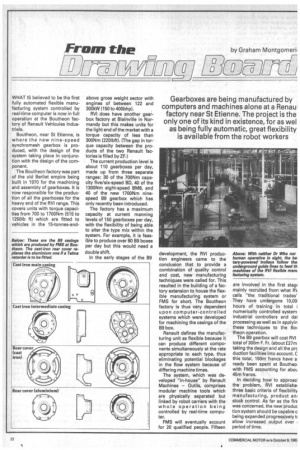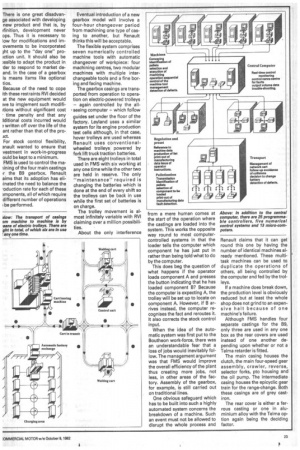From the
Page 18

Page 19

If you've noticed an error in this article please click here to report it so we can fix it.
[TC1 ail qj )Lairric 0 by Graham Montgomerii WHAT IS believed to be the first fully automated flexible manufacturing system controlled by real-time computer is now in full operation at the Boutheon -factory of Renault Vehicules Industriels.
Boutheon, near St Etienne, is where the new nine-speed synchromesh gearbox is produced, with the design of the system taking place in conjunction with the design of the component.
The Boutheon factory was part of the old Berliet empire being built in 1970 for the machining and assembly of gearboxes. It is now responsible for the production of all the gearboxes for the heavy end of the RVI range. This covers units with torque capacities from 700 to 1700Nm (515 to 1250Ib ft) which are fitted to vehicles in the 15-tonnes-and above gross weight sector with engines of between 122 and 300kW (150 to 400bhp).
RVI does have another gearbox factory at Blainville in Normandy but this makes units for the light end of the market with a torque capacity of less than 300Nm (220Ibft). (The gap in torque capacity between the products of the two Renault factories is filled by ZF.) The current production level is about 110 gearboxes per day, made up from three separate ranges: 30 of the 700Nm capacity five/six-speed BD, 40 of the 1300Nm eight-speed BM8, and 40 of the new 1700Nm ninespeed B9 gearbox which has only recently been introduced.
The factory has a maximum capacity at current manning levels of 150 gearboxes per day, with the flexibility of being able to alter the type mix within the system. For example, it is feasible to produce over 80 B9 boxes per day but this would need a double shift.
In the early stages of the B9 development, the RVI production engineers came to the conclusion that to provide a combination of quality control and cost, new manufacturing techniques were called for. This resulted in the building of a factory extension to house the flexible manufacturing system or FMS for short. The Boutheon factory is thus very dependent upon computer-controlled systems which were developed for machining the casings of the B9 box.
Renault defines the manufacturing unit as flexible because it can produce different components simultaneously at the rate appropriate to each type, thus eliminating potential blockages in the flow system because of differing machine times.
The system, which was developed "in-house" by Renault Machines — Outils, comprises modular machine tools which are physically separated but linked by robot carriers with the whole operation being controlled by real-time computer.
FMS will eventually account for 20 qualified people. Fifteen are involved in the first stew mainly recruited from what calls "the traditional trades' They have undergone 10,00 hours of training in total i numerically controlled system industrial controllers and dal processing as well as in applyin these techniques to the Bot theon operation.
The B9 gearbox will cost RVI total of 300m F. Fr. (about £27m taking the design and all the prc duction facilities into account. C this total, 150m francs have al ready been spent at Boutheol with FMS accounting for abou 45m francs.
In deciding how to approacl the problem, RVI establishel three basic criteria of flexibility manufacturing, product am stock control. As far as the firs was concerned, the new produc tion system should be capable o being expanded progressively tt allow increased output over ; period of time. There is one great disadvange associated with developing new product and that is, by ofinition, development never bps. Thus it is necessary to low for modifications and imovements to be incorporated ;ht up to the "day one" proiction unit. It should also be )ssible to adapt the product in der to respond to market deand. In the case of a gearbox is means items like optional tios.
Because of the need to cope ith these restraints RVI decided at the new equipment would we to implement such modifirtions without significant cost • time penalty and that any iditional costs incurred would written off over the life of the ant rather than that of the proJct.
For stock control flexibility, 3nault wanted to ensure that vestment in work-in-progress ould be kept to a minimum.
FMS is used to control the matining of the four main castings ir the 69 gearbox. Renault aims that its adoption has eliMated the need to balance the -oduction rate for each of these )mponents, all of which require different number of operations
■ be performed. Eventual introduction of a new gearbox model will involve a four-hour changeover period from machining one type of casing to another, but Renault thinks this will be acceptable.
The flexible system comprises seven numerically controlled machine tools with automatic changeover of workpiece: four machining centres, two modular machines with multiple interchangeable tools and a fine boring and facing machine.
The gearbox casings are transported from operation to operation on electric-powered trolleys — again controlled by the allseeing computer — which follow guides set under the floor of the factory. Leyland uses a similar system for its engine production test cells although, in that case, hover trolleys are used whereas Renault uses conventionalwheeled trolleys powered by fork lift truck traction batteries.
There are eight trolleys in total used in FMS with six working at any one time while the other two are held in reserve. The only "maintenance" required is changing the batteries which is done at the end of every shift so the trolleys can be back in use while the first set of batteries is on charge.
The trolley movement is almost infinitely variable with RVI claiming over a million possibilities.
About the only interference from a mere human comes at the start of the operation where the castings are loaded into the system. This works the opposite way round to most computercontrolled systems in that the loader tells the computer which component he has just put in rather than being told what to do by the computer.
This does beg the question of what happens if the operator loads component A and presses the button indicating that he has loaded component B? Because the computer is expecting A, the trolley will be set up to locate on component A. However, if B arrives instead, the computer recognises the fact and reroutes it. It also corrects the stock control input.
When the idea of the automatic system was first put to the Boutheon work-force, there was an understandable fear that a loss of jobs would inevitably follow. The management argument was that FMS would improve the overall efficiency of the plant thus creating more jobs, not less, in other areas of the factory. Assembly of the gearbox, for example, is still carried out on traditional lines.
One obvious safeguard which has to be built into such a highly automated system concerns the breakdown of a machine. Such an event must not be allowed to disrupt the whole process and Renault claims that it can get round this one by having the number of identical machines already mentioned. These multitask machines can be used to duplicate the operations of others, all being controlled by the computer and fed by the trolleys.
If a machine does break down, the production level is obviously reduced but at least the whole shop does not grind to an expensive halt because of one machine's failure.
Although FMS handles four separate castings for the B9, only three are used in any one box as the rear covers are used instead of one another depending upon whether or not a Telma retarder is fitted.
The main casing houses the clutch, the main four-speed gear assembly, crawler, reverse, selector forks, pto housing and the oil pump. The intermediate casing houses the epicyclic gear train for the range-change. Both these casings are of grey castiron.
The rear cover is either a ferrous casting or one in aluminium alloy with the Telma option again being the deciding factor.
































































